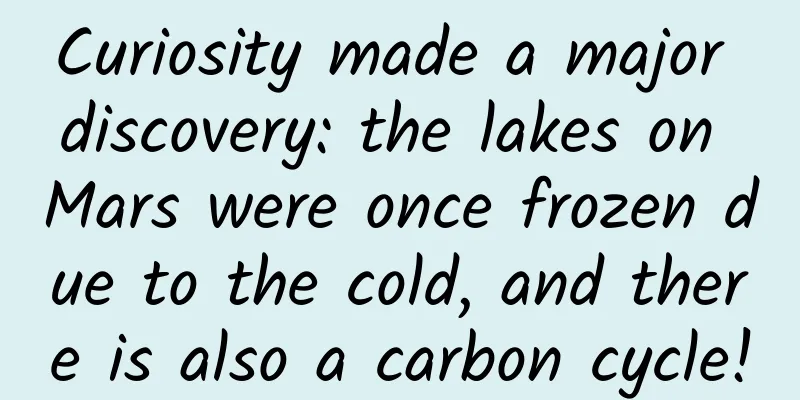Curiosity made a major discovery: the lakes on Mars were once frozen due to the cold, and there is also a carbon cycle!

|
[Mobile software: Bo Ke Yuan] By studying the chemical elements on Mars, scientists can work backwards and piece together the history of Mars, a planet that once had the conditions needed to sustain life. Weaving this story element by element from Earth, about 140 million miles (225 million kilometers) away, is a painstaking process. But scientists are not the kind to be easily intimidated, and orbiters and rovers on Mars have confirmed that clues including dry riverbeds, ancient coastlines and salty surface chemistry indicate that Mars once had liquid water. Using NASA's Curiosity rover, scientists have found evidence of long-standing lakes on Mars. They have also unearthed organic compounds, the chemical building blocks of life. The combination of liquid water and organic compounds compels scientists to continue searching Mars for signs of past or present life. Despite the tantalizing evidence found so far, scientists' understanding of Mars' history is still unfolding, with several major questions open to debate. First, was the ancient Martian atmosphere thick enough to keep Mars warm, and therefore wet, for the long periods of time needed to germinate and nurture life? As for organic compounds: Are they signs of life, or are they signs of chemistry that occurs when Martian rocks interact with water and sunlight? In new research published in the journal Nature Astronomy, scientists provide some insights to help answer these questions. The multi-year experiment was conducted in a chemistry laboratory inside Curiosity's belly, called Sample Analysis at Mars (SAM). The study found that certain minerals in rocks in Gale Crater could have formed in lakes on the ice cap. These minerals could have formed during a cold phase sandwiched between warm periods, or after Mars lost most of its atmosphere and began to become permanently cold. Cold and icy conditions on Mars Gale Crater, about the size of Connecticut and Rhode Island combined, was chosen as the landing site for the Curiosity rover because it has signs of past water, including clay minerals that could help trap and preserve ancient organic molecules. In fact, while exploring the base of a mountain called Mount Sharp in the center of the crater, Curiosity found a 1,000-foot (304-meter) thick layer of sediment that was deposited as mud in ancient lakes. To form so much sediment, incredible amounts of water would have flowed into these lakes, continuing warm and wet conditions for millions to tens of millions of years. But some geological features in the crater also hint at a past that included cold, icy conditions. "At some point, the surface environment of Mars must have experienced a transition from warm and wet to cold and dry, like it is today, but exactly when and how that transition occurred remains a mystery," said Heather Franz, a geochemist at NASA's Goddard Space Flight Center in Greenbelt, Maryland. Franz, who led the Martian sample analysis study, noted that factors such as changes in Mars' tilt and the amount of volcanic activity could have caused the Martian climate to alternate between warm and cold over time. Chemical and mineralogical variations in Martian rocks support this idea, suggesting that some layers formed in cooler environments and others in warmer ones. But in any case, the array of data collected so far by the Curiosity rover suggests that the team sees evidence of Martian climate change recorded in rocks. The team found evidence of Mars' cold ancient environment after the Sample Analysis Laboratory at Mars extracted carbon dioxide and oxygen from 13 dust and rock samples that Curiosity collected over five Earth years (Earth years to Martian years). Carbon and oxygen in the Martian climate story Carbon dioxide is a molecule in which a carbon atom is bound to two oxygen atoms, and carbon is a key witness to the mysterious Martian climate. In fact, this simple and versatile element is as vital as water in the search for life elsewhere. On Earth, carbon flows continuously through the air, water, and surface, a cycle that is well known to depend on life. Plants, for example, absorb carbon from the atmosphere in the form of carbon dioxide. In return, they produce oxygen, which humans and most other life forms use for respiration in the process. Eventually the carbon is released into the air again via carbon dioxide, or into the Earth's crust as life forms die and become buried. Scientists have discovered that the carbon cycle also occurs on Mars and are working to understand it. While the Red Planet may have had little water and may have once been rich in surface life, the carbon cycle has been very different from Earth's, at least for the past 3 billion years. "Nevertheless, the carbon cycle is still going on and it's still important because it not only helps reveal information about Mars' ancient climate, it also shows us that Mars was a dynamic planet that was cycling elements, and those elements are the building blocks of life," said Paul Mahaffy, director of NASA Goddard and principal investigator of SAM. Provide conditions After Curiosity delivered rock and dust samples to the Sample for Mars Analysis lab, it heated each sample to nearly 1,650 degrees Fahrenheit (900 degrees Celsius) to release the gases inside. By looking at the temperatures at which carbon dioxide and oxygen are released, scientists can tell which minerals the gases came from, information that can help understand how carbon cycles on Mars. Various studies have suggested that Mars' ancient atmosphere, which contained mostly carbon dioxide, may have been thicker than Earth's. Much of it has been lost to space, but some of it may be stored in rocks on the Martian surface, particularly in the form of carbonates, which are minerals made of carbon and oxygen. On Earth, carbonates are created when carbon dioxide from the air is absorbed by the oceans and other bodies of water and then mineralized into rock. Scientists think the same process happened on Mars, and it could help explain what happened to part of the planet's atmosphere. However, Mars missions haven't found enough carbonates on the planet's surface to support a thick atmosphere. Still, the few carbonates that Sample From Mars did detect revealed some interesting information about the planet's climate through the carbon and oxygen isotopes stored in them -- different versions of an element with different masses. Because different chemical processes, from rock formation to biological activity, use these isotopes in different proportions, the ratio of heavy to light isotopes in rocks provides scientists with clues to how the rocks formed. In some of the carbonates found in the Martian sample analysis, scientists noticed oxygen isotopes that were lighter than those in the Martian atmosphere. This suggests that the carbonates were not formed long ago simply by carbon dioxide from the atmosphere being absorbed into lakes. If that were the case, the oxygen isotopes in the rocks would be slightly heavier than those in the air. Although it is possible that the carbonates formed very early in Mars' history, when the composition of the atmosphere was slightly different than it is today. Where does all the carbon go? But the researchers think it's more likely that the carbonates formed in frozen lakes. In that case, the ice could have absorbed the heavy oxygen isotopes and left behind the lightest ones, which then formed carbonates. Other Curiosity scientists have also presented evidence that ice-covered lakes may have existed in Gale Crater. The low abundance of carbonates on Mars is puzzling. If Gale Crater doesn't have much of these minerals, perhaps the early Martian atmosphere was thinner than expected, or perhaps something else was storing the missing atmospheric carbon. According to the analysis, some of the carbon could be sequestered in other minerals, such as oxalates, which store carbon and oxygen in a different structure than carbonates, a hypothesis based on the temperatures at which some samples released carbon dioxide from the Mars sample analysis (too low for carbonates but just right for oxalates) and different carbon and oxygen isotope ratios than scientists see in carbonates. Oxalates are the most common type of organic mineral produced by plants on Earth, but oxalates can also be produced without living things. Carbonate molecule model One way is through the interaction of atmospheric carbon dioxide with surface minerals, water, and sunlight, a process called abiotic photosynthesis. This chemistry is hard to find on Earth, where life is abundant, but the research team hopes to create abiotic photosynthesis in the lab to find out if it is indeed responsible for the carbon chemistry seen in Gale Crater. On Earth, abiotic photosynthesis may have paved the way for photosynthesis in some of the earliest microscopic life forms, which is why the discovery of photosynthesis on other planets is of interest to astrobiologists. Even if it turns out that abiotic photosynthesis locked some of the atmospheric carbon into the rocks of Gale Crater, researchers would like to study soil and dust from different parts of Mars to see if the results in Gale Crater reflect a global picture of Mars. There may be a chance to do this one day: NASA's Perseverance rover is scheduled to launch to Mars in July-August 2020 and plans to collect samples in Jezero Crater for possible return to laboratories on Earth. Bo Ke Yuan | Research/From: NASA Goddard Space Flight Center The study was published in the journal Nature Astronomy BoKeYuan|Science, technology, research, popular science Follow [Bokeyuan] to see more beautiful cosmic science |
<<: Zero Waste Living Guide - "Z Generation Zero Waste Living Report"
>>: Why is allergic rhinitis more common in autumn? Can it be cured?
Recommend
Lu Zhanka's 30-day short video oral broadcast training camp teaches you how to make money from short videos [Video Course]
Lu Zhanka's 30-day short video oral broadcast...
Danmu website layout: A site is on the left and B site is on the right
On August 6, AcFun (A站), the originator of domest...
NIO: Sales in January 2021 increased by 352.1% year-on-year, and 7,225 vehicles were delivered, setting a new record
On February 1, 2021, NIO just released its delive...
How to re-flash iOS 11 and downgrade to iOS 10: without losing data
Apple recently released the official iOS 11 syste...
What are the equipment for real-name authentication at construction sites?
With the introduction of various national policie...
Tonight, the Geminid meteor shower fills the sky. Where can I watch it? Can I take photos?
Tonight is the day of the annual Geminid meteor s...
What exactly is the 2.5D glass that manufacturers are always boasting about? Is it very powerful?
Since the release of iPhone 6 last year, there ha...
If your eyes feel "tired", it is actually reminding you...
Dry eyes, sore eyes, swollen eyes, As I read the ...
How much does it cost to develop Foshan’s fresh food WeChat mini program and a fresh food mall WeChat mini program?
With the continuous advancement of the Internet, m...
A complete event operation and promotion!
All operating systems and organizations are only ...
How much does it cost to attract investment in Liupanshui Textile and Leather Mini Program?
How much does it cost to attract investment for t...
Pew: Survey shows that more than 80% of Americans do not use AI at work
According to Business Insider, although American t...
In the AI era, will APP operations be eliminated?
As early as August 8, the official account of Chi...
Geely to invest at least $1.9 billion to revive Luster sports car
Zhejiang Geely Holding Group is considering spend...









